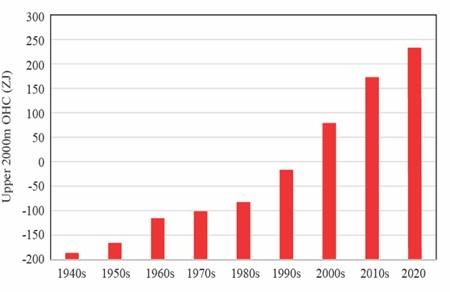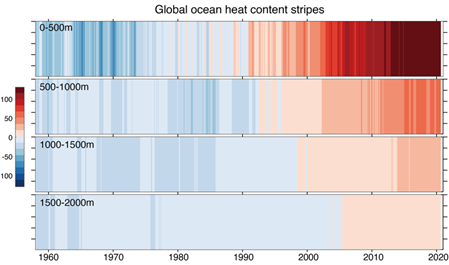Climate change continues to set records in 2020

In this section for submissions by our Fellows, Dr Kevin Trenberth Hon FRSNZ discusses the important role of oceans in controlling our climate, but how, due to human-induced changes, they have warmed at unprecendented rates, leading to record-breaking annual land temperatures and stronger, more frequent storms.
The global mean surface temperatures for 2020 are either tied for first as warmest (NASA, Copernicus (Europe)) or a close second (NOAA, UK Met. Office). A better, more robust indicator of the warming planet is the global ocean heat content (OHC).
Global warming arises from human-induced changes in atmospheric composition, especially increases in carbon dioxide. This creates a blanketing effect that traps radiation, and over 90% of the extra heat ends up in the ocean. The oceans are now hotter than they have been in recorded history. The integrating effect of the oceans makes the ocean heat content the best single indicator of whether the planet is warming or not. Scientists show that the five hottest years ever recorded have occurred since 2015. A closely related effect is that sea level has risen to be the highest on record, directly affecting coastal New Zealand regions.
In addition, warmer oceans supercharge the weather, creating more powerful storms and hurricanes. Warmer oceans lead to a warmer moister atmosphere that promotes more intense rainfalls in all storms, and especially hurricanes, increasing risk of flooding. In the North Atlantic, a record number of named storms occurred in 2020, affecting the Americas. Record numbers of typhoons made landfall in Vietnam after blasting the Philippines, and Fiji was recently devastated by a category 5 hurricane, Yasa. Similarly, powerful storms are increasing in frequency elsewhere around the globe.
The latest data reveals that the upper 2000 meters of the world’s oceans in 2020 have absorbed 20 Zettajoules compared to last year (1 Zettajoule is equivalent to 1,000,000,000,000,000,000,000 Joules, a unit of energy) so that means the oceans have absorbed heat at a rate of 640,000,000 MegaWatts (640 TeraWatts) or over 100 times all the electricity used around the world (5.7 TW in 2018). Each of the last nine decades have been warmer than the prior decade. The ocean heating by layer, as the heat penetrates slowly to greater depth, can also be seen.

Fig. 1. Ocean heating, by decade, since the 1940s.

Fig. 2. Global ocean energy absorption by depth from 1958 to 2020. Units: ZJ.
These results were published in mid-January in Advances in Atmospheric Sciences and this latest study is another clarion call for humans to take action on climate change. Related articles are in The Listener, at NCAR, and Wired.
To contact the author:
Email Dr Kevin Trenberth Hon FRSNZ.
If Fellows would like to respond or comment on the topics in the Fellows' Forum newsletter discussion section, please email the academy and your letter will be included in the next newsletter.
